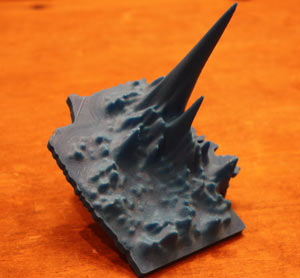The Physical Realm of Natural Disasters and Crime: Doug McCune's 3D Printed Art
Doug McCune is a programmer by day and artist by night. In his 10 years of programming, he has a lot of experience in mapping data such, as natural disasters. He decided to integrate his artistic side to transform the data he is exposed to professionally and to visually tell a story of his city.
“I live in San Francisco and experiment with data from this area. I love that my art tells me – and others – about where I live. I also work a lot with natural disaster data, which has been fun to explore artistically. I’ll take the data and work in my garage at night exploring ways to transform it into the physical realm with 3D printing. Most recently I 3D printed the South Napa Earthquake.”
What a Crime
McCune’s 3D art has explored not only the physical realm of natural disasters, but also of crime rates. “I’m always drawn to slightly morbid topics,” laughed McCune, “so the crime stuff is definitely interesting, especially how it resonates with people. When they see the Stalagmite Crime Map from where they live, or grew up, they are intrigued. People like trying to figure out where they live compared to the peaks. For example, I’m in a pretty tame area, depending on the crime you are looking at,” said McCune, chiming in, “I’m relatively close to a small peak for narcotics crime, though!”

“One of my favorite maps to show people is the prostitution map, because it is so clustered in certain spots in San Francisco. However, I try to emphasize when I show the map that this is where cops are making arrests, not necessarily where the crime is taking place in general, which adds to the extremity of the map, since the arrests are in two man sections of the city.”
Pulling the Trigger on 3D Printing
“My first experience with 3D printing was through a service bureau, but it was getting expensive to order my prints through them, since they charge by volume. I found myself always hesitating on my order when I had to commit to the prices, which quickly reached hundreds of dollars. Eventually I wasn’t pulling the trigger on creating models, and I didn’t like that. So, I decided to purchase a printer. Once you own one, you print what you want and you don’t have as much of a barrier. You can also modify the fill settings and adjust the density, which enables you to use less filament.”
Attention on Afinia
“The Afinia 3D printer was – and still is – my first and primary printer. I purchased it a couple of years ago, around 2012. I was looking for something that wasn’t DIY. One day, I tweeted a different company asking how I could get their printer quickly, and right away Afinia responded saying they could ship one in a couple of days. They offered to test print one of my models to I could see the quality of the print. That was enough to sell me. The response time and the attention they give their customers can’t be beat.”
“Since I’ve had it, it’s worked great. I haven’t even needed to contact their support, since the questions I have are usually covered in online forums.”
Feeling Data
“I did a project doing 3D rendering of crime data and it became really popular. People responded well to that method of data visualization. I didn’t have a background in 3D or making models, but it was an experiment and I was surprised how much it resonated with people. The next obvious thing was to make a physical representation. I found myself on the computer spinning around the models in the software and wanting to feel that, to turn the peaks into something you can run your fingers over.”
“What 3D printing does is bring out a much more emotional reaction to what people already know about the city. People know there is a lot of crime in the Tenderloin, but it isn’t until you see the difference in the exaggerated 3D form that the weight settles in. When you walk through the area, you can feel that it is dangerous – but you don’t realize how much more so than other parts of the city.”
Converting Data to 3D Prints
“The natural disaster data typically comes from the US government, like USGS or NOAA.”

“Essentially, it’s shapes on a map that represents how bad the disaster was in those areas. I’ve been working on software that can convert those shapes into a 3D model. It takes an attribute of the data and converts it to height. It could be volume of shaking, for instance, or the speed of wind. Each shape gets lifted to a certain height based on the value in data. It works basically the same with the demographic crime data. Anything I can plot on a map can be converted to a 3D model.”
McCune’s software is open-source and can be found on his GitHub page.
The Diode Gallery for Electronic Art

“Josh Michaels, who recently opened the Diode Gallery for Electronic Art in Portland, OR, happened to also speak at a conference called 360|Intersect where I presented some of my work. He reached out to me when he opened the gallery and explained his vision for an art gallery focused on technology. He asked me if I was interested, which I was, so now I will be presenting in April of 2015. I’ll be showing my 3D printed crime, a laser cut project of Haiti’s earthquake, and some new stuff, too.”
The gallery is open to the public, free of charge.



